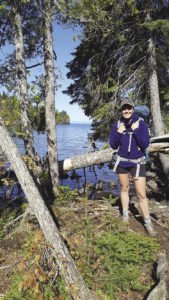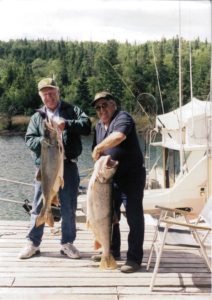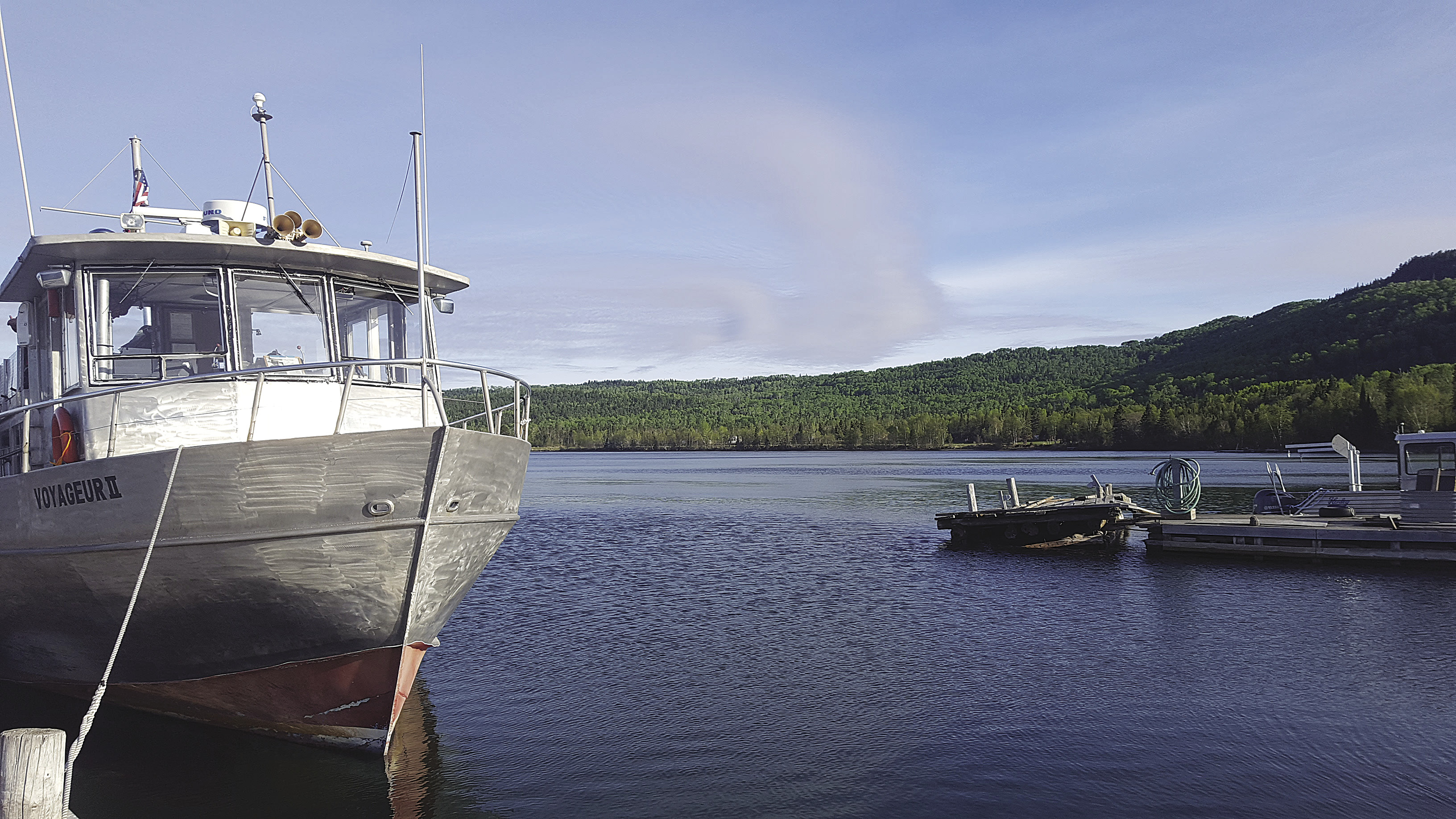The largest island on Lake Superior measures nine miles across, 45 miles long, and encompasses more than 132,000 land acres. Both Native American copper miners and commercial fishing families called this island home long before Roosevelt officially established it and the rest of the archipelago as a national park in 1940. Forty years later it was designated an International Biosphere Reserve because of its unique ecosystem.
Renowned Isle Royale and its surrounding 450 smaller islands sit in the northwest portion of Lake Superior. As four-fifths of the surface area of the official national park is water, boating to and around the island is a popular means of exploration of its many bays and harbors.
An avid camper ready for any excuse to be in the wilderness, I made my maiden expedition to one of the least visited national parks via the 65-foot aluminum Voyageur II passenger ferry. This particular voyage, which is operated by Grand Portage Isle Royale Transportation Lines, is a two-hour jaunt from Grand Portage to the Windigo Visitor Center on the western side of the island. While I hopped off the boat at its first stop, the Voyageur II continues a clockwise circumnavigation of the island on each trip, dropping passengers at various trailheads and paddling embarkation points.
Grand Portage Isle Royale Transportation Lines was started by the Sivertson family to transport their catch of fish from the island back to the North Shore of Minnesota. In the present day, Captain Don Szczech runs the passenger ferry business with his business partner Jennifer Sivertson, the granddaughter of Stanley Sivertson.

“I have been coming to Isle Royale for over 25 years now. I fished at the island every week consecutively for 10 years. I operated a charter fishing business and became acquainted with the ferry operators of the day and assisted with mechanical issues that might have come up from time-to-time. When the ferry business came up for sale it just seemed like buying it was the thing to do,” explained Captain Don.
The business includes two vessels, the aforementioned Voyageur II and the Sea Hunter III. Though the capacity for the Voyageur II is 46 passengers (the Sea Hunter III can take 60), on this particular Saturday morning in early June, our numbers were only in the teens. According to National Park Service representative Valerie Martin, this is normal.
“The first week of August is when the majority of visitors come. May and June are really quiet because people are afraid of bugs—but they are usually wrong! It doesn’t really get busy until about the second week in July; then it’s really busy until the middle of August all around the island. It stays pretty high until Labor Day, when the lodge closes on the east end. When the passenger service schedules start dropping off, it drops really quickly. Later September and really early October, when the last ferries are running, it’s a really quiet place again.”
Martin, who has worked for the National Park Service on Isle Royale every summer since 1999, has noticed an increase in recent years in the number of sailboats coming to the island and a decrease in power boats.
“There used to be a lot more people coming in their private boats. There are a lot fewer nowadays, although we saw a change in that last year. The last two years have been really dramatic for this park. Our visitation for the Park Service Centennial popped up significantly and then we thought it was going to go back to normal, but visitation rose again last year. We’ll see what happens down the road,” she said.
Tim Quaife and his dad Mike Quaife are two of those private boaters who have been fishing the island since the 1970s. Primarily catching lake trout—and the occasional salmon—the two would take overnight circumnavigation trips from both Grand Portage and Grand Marais.

“The 21-foot high side boat we take out there has made 100 trips. The best trips were when we left from Grand Portage, went to Siskiwit Bay to fish, and then to Rock Harbor and rented a cabin to stay overnight. If you’re lucky you can get there in time to eat dinner at the Rock Harbor Lodge,” said Mike. “The next day we’d go around the rest of the island. Just a two-day trip and go all the way around.”
Though on his first trips he went to Todd Harbor to fish, he believes the fish are better on the southern side in Siskiwit Bay. No matter the fish haul, however, both father and son have nothing but praise for the island.
“There’s no other place that’s so pristine, with the reefs and the fishing. You just don’t have that anywhere else. You get the feeling from everyone that it’s always their objective to get to Isle Royale because of the fishing and the beauty of the island,” said Mike.
Outstanding natural beauty aside, many who have ventured out on the lake are all too aware of the seemingly instantaneous changes in the conditions while making passages and exploring various islands. Captain Don’s years on the water have afforded him some harrowing times.
“I was fishing when the storm that caused the blowdown of 1999 came over the lake. It was quite a sight to see it approach as the day was so foggy that visibility was less than 50 feet. Like magic, the fog lifted in an instant and off in the distance there was a green cloud that blocked the horizon. We had some strong wind, but it came and went so quickly that the lake really didn’t have much time to get really rough. The seiche that followed was really something to see, four-foot changes in the lake level at the dock every 20 minutes. I have only seen that wide of a change once since then,” mused Captain Don.
The Quaifes have also weathered rough storms during their many trips across Lake Superior.
“We’ve had to put up with rough weather and fog periodically. You use your GPS or radar if you have it; sometimes we didn’t have either one. Just a compass in the middle of the floor,” said Mike.

“Seasick—been there quite a few times,” said Tim.
I could definitely relate to that sentiment as my stomach turned on that windy and wavy morning in June. Glaring at the horizon with as much focus as I could muster, I made a mental note that this was probably the smallest boat I would ever want to take across Superior. Pulling into the calm bay offered a welcome change; I was finally able to enjoy the scenery from the deck of the boat.
With no plan to cast a line during my trip to the pristine national park, I donned my backpack for a four-day, three-night trek. This, I would later learn, is the average length of stay (and the longest of any of the national parks). Other visitors spend their time away from the mainland scuba diving, canoeing and kayaking.
During my 39-mile clockwise traverse from Windigo, I was fortunate enough to see nine of the estimated 1,500 moose that live on the island. As a quiet human, I did not phase them; more than once we made eye contact as I tried to convince them to mosey off the trail so I could press on to the next campsite on my itinerary. The camping varied from modest, lean-to structures to unadorned tent sites.
While some of the other hikers on the trail had arrived via seaplane from Houghton, Michigan, many take the commercial ferry from various other locations in Michigan. The Ranger III from Houghton and the Isle Royale Queen IV from Copper Harbor offer trips to Rock Harbor on the eastern side of the island. Schedules for all methods of transportation to the park are available on the Isle Royale National Park website (nps.gov/isro).
Arrivals to the park require check-in at the Visitor Center Office in Windigo or Rock Harbor, though private boaters can permit in advance though the park website. As a Park Service representative, Martin cautions all boaters to come prepared with your boat “ship shape condition” and to be “very prepared for changes in the weather and your itinerary”.
As I begrudgingly boarded the Voyageur II in Windigo around midday that following Tuesday, I was greeted with—and quite thankful for—smooth seas for our return trip. Whether absorbing Isle Royale National Park’s absolute solitude by boat or by foot, I wish you a safe and serene passage.





